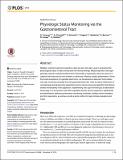| dc.contributor.author | Schwartz, S. | |
| dc.contributor.author | Ciccarelli, Gregory A. | |
| dc.contributor.author | Hughes, Tadd B. | |
| dc.contributor.author | Boettcher, Tara L. | |
| dc.contributor.author | Barman, Ross | |
| dc.contributor.author | Swiston, Albert J., Jr. | |
| dc.contributor.author | Langer, Robert S | |
| dc.contributor.author | Traverso, Carlo Giovanni | |
| dc.date.accessioned | 2015-11-20T13:03:53Z | |
| dc.date.available | 2015-11-20T13:03:53Z | |
| dc.date.issued | 2015-11 | |
| dc.date.submitted | 2014-07 | |
| dc.identifier.issn | 1932-6203 | |
| dc.identifier.uri | http://hdl.handle.net/1721.1/99940 | |
| dc.description.abstract | Reliable, real-time heart and respiratory rates are key vital signs used in evaluating the physiological status in many clinical and non-clinical settings. Measuring these vital signs generally requires superficial attachment of physically or logistically obtrusive sensors to subjects that may result in skin irritation or adversely influence subject performance. Given the broad acceptance of ingestible electronics, we developed an approach that enables vital sign monitoring internally from the gastrointestinal tract. Here we report initial proof-of-concept large animal (porcine) experiments and a robust processing algorithm that demonstrates the feasibility of this approach. Implementing vital sign monitoring as a stand-alone technology or in conjunction with other ingestible devices has the capacity to significantly aid telemedicine, optimize performance monitoring of athletes, military service members, and first-responders, as well as provide a facile method for rapid clinical evaluation and triage. | en_US |
| dc.description.sponsorship | United States. Dept. of the Air Force (Air Force Contract FA8721-05-C-0002) | en_US |
| dc.description.sponsorship | United States. Dept. of Defense. Assistant Secretary of Defense for Research & Engineering | en_US |
| dc.description.sponsorship | National Institutes of Health (U.S.) (Grant EB000244) | en_US |
| dc.description.sponsorship | National Institutes of Health (U.S.) (Grant T32DK7191-38-S1) | en_US |
| dc.language.iso | en_US | |
| dc.publisher | Public Library of Science | en_US |
| dc.relation.isversionof | http://dx.doi.org/10.1371/journal.pone.0141666 | en_US |
| dc.rights | Creative Commons Attribution | en_US |
| dc.rights.uri | http://creativecommons.org/licenses/by/4.0/ | en_US |
| dc.source | PLoS | en_US |
| dc.title | Physiologic Status Monitoring via the Gastrointestinal Tract | en_US |
| dc.type | Article | en_US |
| dc.identifier.citation | Traverso, G., G. Ciccarelli, S. Schwartz, T. Hughes, T. Boettcher, R. Barman, R. Langer, and A. Swiston. “Physiologic Status Monitoring via the Gastrointestinal Tract.” Edited by Ruud van den Bos. PLOS ONE 10, no. 11 (November 18, 2015): e0141666. | en_US |
| dc.contributor.department | Lincoln Laboratory | en_US |
| dc.contributor.department | Massachusetts Institute of Technology. Department of Chemical Engineering | en_US |
| dc.contributor.department | Koch Institute for Integrative Cancer Research at MIT | en_US |
| dc.contributor.mitauthor | Traverso, Gio | en_US |
| dc.contributor.mitauthor | Ciccarelli, Gregory A. | en_US |
| dc.contributor.mitauthor | Schwartz, S. | en_US |
| dc.contributor.mitauthor | Hughes, Tadd B. | en_US |
| dc.contributor.mitauthor | Boettcher, Tara L. | en_US |
| dc.contributor.mitauthor | Barman, Ross | en_US |
| dc.contributor.mitauthor | Langer, Robert | en_US |
| dc.contributor.mitauthor | Swiston, Albert J., Jr. | en_US |
| dc.relation.journal | PLOS ONE | en_US |
| dc.eprint.version | Final published version | en_US |
| dc.type.uri | http://purl.org/eprint/type/JournalArticle | en_US |
| eprint.status | http://purl.org/eprint/status/PeerReviewed | en_US |
| dspace.orderedauthors | Traverso, G.; Ciccarelli, G.; Schwartz, S.; Hughes, T.; Boettcher, T.; Barman, R.; Langer, R.; Swiston, A. | en_US |
| dc.identifier.orcid | https://orcid.org/0000-0002-4260-2785 | |
| dc.identifier.orcid | https://orcid.org/0000-0003-2780-3324 | |
| dc.identifier.orcid | https://orcid.org/0000-0003-4255-0492 | |
| mit.license | PUBLISHER_CC | en_US |
| mit.metadata.status | Complete | |
